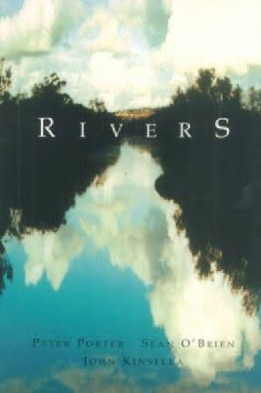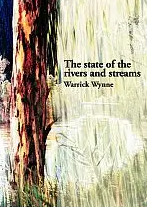
- Free Article: No
- Contents Category: Poetry
- Review Article: Yes
- Article Title: Deep River
- Online Only: No
- Custom Highlight Text:
Rivers are important to us in all sorts of ways: usefully symbolic for poets, often loved in childhood while ‘messing about in boats’, sucked dry by cotton farmers, worried over by environmentalists, boosted by local patriots, and so on. The indefatigable Australian poet John Kinsella was certainly onto a good idea when he recruited two other poets based in England to join him in a three-way livre composé about the subject.
- Book 1 Title: Rivers
- Book 1 Biblio: FACP, $21.95 pb, 83pp
- Book 1 Cover Small (400 x 600):

- Book 1 Cover (800 x 1200):

- Book 2 Title: The State of the Rivers and the Streams
- Book 2 Biblio: Five Islands Press, $16.95 pb, 69pp
- Book 2 Cover Small (400 x 600):

- Book 2 Cover (800 x 1200):

The first of these is Peter Porter who, in the opening twenty-eight pages of the collection, demonstrates his usual linguistic sophistication and ironic ‘take’ on the subject. The rivers concerned vary widely, from his own Brisbane River in flood in 1893 to more symbolic European rivers, such as the Rubicon, the Guadalquivir, the Rhine and the Thames. The tone shifts from the unusually lyrical (for Porter) through to the sardonic and the outright comic.
The opening poem, ‘River Run’, is particularly striking, tracing an anonymous, quintessential river from its birth (‘There is no source, though something like a bird / distances the very distance in its hoverings’) through to its middle age (‘Wide as a yawn, the slow-coach river now / bastes in itself and boils the leaves / upon its surface: it is going home’). It finishes with the fatuous ‘hope never to reach the pounding Heads’ and the ironic suggestion that ‘The river has no start // how could it bring us to a proper end’.
Another major poem in Porter’s section is the elaborately titled ‘The Role of the Brisbane River in the Fortunes of My Family’. Here we have a potted family history, but Porter lifts his poem above this dubious genre with the symbolism via which the river first creates the family fortunes and then destroys them, leaving the family ‘doomed to genteel poverty / which lasted well beyond my birth’. Brisbane’s subsequent restoration to ‘health’ is also seen with typical Porter irony: ‘Queensland, once Louisiana, turns / Super Texas, primus inter pares.’
Other poems or sequences such as ‘River Quatrains’, ‘River Rorts’ and ‘Epilogue’ are almost light verse. One of the best of these notes: ‘Our City Fathers’ planning is polite. /The abattoir is on the edge of town. / Yet out of mind may not be out of sight; / Here on, the river runs a darker brown.’ More problematic for some readers may be ‘The Rhine’, Porter’s ‘version’ of Hölderlin’s poem ‘Der Rhein’. Here Porter takes on a different, much less familiar voice, true perhaps to Hölderlin’s German, but not to the London wit we’ve grown used to. ‘Glorious the awakening from / the most serene of sleeps, / entering then the coolest woods / to walk at evening while the light grows mild.’
Sean O’Brien and Porter may live in the same country, but they are very different poets. For O’Brien rivers are full of death and history: ‘ … below us / The dark peopled water //Was leaning and listening.’ O’Brien’s poetry is full of visceral, graphic and often slightly surreal imagery. He seems, unlike many poets, to have an easy, intuitive grasp of free verse rhythms, though he is also capable of turning off a traditional quatrain when the mood takes him, as in ‘Song to be Sung by Susie Rivers’. ‘Catch me one evening / If you happen by / With a pound in your pocket / And a glint in your eye.’ He even employs little-used triple measures, anapæsts and dactyls. ‘People do murders to live in a house / Where an actual river runs past at the back.’ Despite his Irish name, O’Brien seems to be very English in his emphasis on rain, wetness and rot. ‘And on the bookshelves // English poets, all gone damp / With good intentions, never read.’ Or, more disturbingly, in the same poem, ‘Water-Gardens’: ‘In King Death’s rainy garden / We were playing out.’
John Kinsella’s final section of Rivers is a rather drier affair. His poems deal with the Western Australian Avon River: ‘Dry riverbed, in the main: abject pools / barely plausible reservoirs of moisture, / sinecures, fermenting fonts, /tailings of flaw and flow … ‘ Kinsella uses a truncated version of Whitman’s catalogue technique, creating poems that read as much like notes for a poem as they do a finished poem. The syntax, as well as the lineation, is staccato, with lots of incomplete sentences and extended listings of details.
As Kinsella says in his Introduction, he is trying, among other things, to address both the white and black histories of the Avon. In the final poem, he argues: ‘It’s pollution / we want to keep out, / but metaphors and symbols / don’t always bridge the gap: people / are not algae, and the blooms / that choke the river / find no place in the language of beauty: the liminal can be exact / and when we forget that / people are wrongly imprisoned, / justice wallows in the drying /riverbed.’
The syntax of the above is typical, somehow off-centre and out of control. This is probably deliberate, to emphasise how his details about the Avon don’t quite add up and tend to reflect the conflicting interests and attitudes of the people along its banks. Its fate is mixed and complex, and Kinsella brings this out well with his rather awkward and angular approach.
Warrick Wynne’s third collection would, from its title, seem to have much in common with the Kinsella project; in the book’s first third, this is the case. Here, the poems are all landscape, geology and weather features, sometimes employed symbolically, as in ‘The River of History’, but more often used simply for their non-human selves. Wynne states at least part of his credo in the opening poem ‘Landscape’: ‘Mine is the marginal no-place / between suburb and bush, / stony places under electric pylons / or creeks under railway bridges.’
The temperament in The State of the Rivers and Streams is essentially melancholic. Even in the last two-thirds of the book, when human beings appear, the predominant theme is their ephemerality and the triumph of entropy. In poems such as ‘The Street of the Dead’, ‘Reunion’, ‘The Shortening Leash’, ‘The Egg Factory’ and ‘My Father’s Advice’, Wynne is preoccupied with things that slip away into memory, finite and fading. Fortunately, this is at least partly offset by a number of more epiphanic moments, as in ‘Love Poem’ and ‘Tin Cup’, which, even while they are retrospective, recognise that something worthwhile and memorable has happened. ‘So love lasts, lies unsoftening, seed-hard. / Until one day a path is re-crossed, / instinct finds you in a forgotten suburb / at a green door / you knew once as well as your own; / it opens, rains pour down, / things begin again.’ (‘Love Poem’)
To judge from his third book, Wynne is a poet who writes directly from his own experience and sensibility. His language is more than sufficiently attentive, thoughtful and vivid to do justice to his particular slant on the world.


Comments powered by CComment